Gardening of the aquarium is one of the key activities that are being implemented in the process of arranging and designing it. The reservoir, decorated with living aquatic plants, acquires a complete and complete look, and in its space in the short term an optimal biological environment is formed. What types of algae are commonly used by aquarists? How to choose, plant, maintain and breed representatives of the aquarium flora? What diseases are aquarium plants susceptible to?

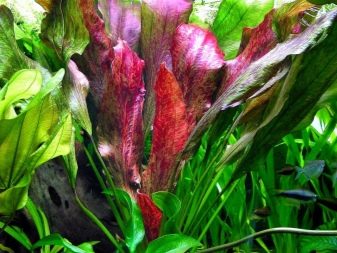
Kinds
The world of aquarium flora is amazingly diverse. Among its representatives there are shade-tolerant and photophilous, unpretentious and capricious, tall, medium-sized and dwarf plants. Before you start filling the aquarium with your favorite instances, you should familiarize yourself with the description and characteristics of each of them. Such prudence will further avoid unpleasant situations associated with the incompatibility of algae, with a difference in their requirements for the conditions of detention or care. Below are the most popular varieties of representatives of the aquarium flora.
Duckweed - a group of several popular varieties of unpretentious aquarium plants. This group includes small, multi-root, three-lobed and humpback duckweed. Plants have leaves of a round or elliptical shape, reaching a length of 3.5 to 10 millimeters. The size and shape of the leaves depend on the type of duckweed. A feature of aquarium duckweed is its tendency to grow rapidly.Under favorable conditions, it is able to fill the entire aquarium in a matter of weeks.
However, experienced aquarists recommend not to throw out excess duckweed, but to dry it and mix it with fish food, since this vegetation contains a lot of useful substances.

Elodea - A very common variety of aquarium plants with long, branching and fragile stems. A characteristic feature of this representative of the aquarium flora is the ability to phenomenally fast growth. Another feature of Elodea is its ability to absorb impurities and impurities present in the water. Thanks to this valuable quality, the water in the aquarium with elodey stays clean and clear for longer.
Javanese moss - A kind of unpretentious water moss of the hypnous family. It is notable for its lush and voluminous urine-like structure. In aquariums, this type of moss is commonly used for decorating tanks. In addition, it is often used as a soft substrate in spawning, as it is able to reliably hide clutch of eggs from fish.
Wallisneria - a group that unites many varieties of aquatic plants, perennials of the family of aquacras. The popularity of these plants in the aquarium is due to their grace, beauty and unpretentiousness. Numerous Wallisnerium emerald rosettes that stretch long narrow leaves to the surface of the water look very impressive in the space of the aquarium. With easy circulation of water, leaves smoothly flutter in its thickness, creating an interesting optical effect.
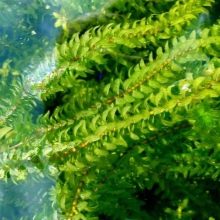
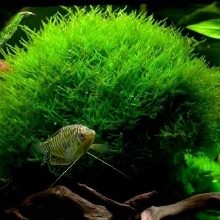

Cryptocorynes - An extensive group of herbaceous amphibian plants of the aroid family. In aquariums, purple and yellow cryptocoryns are the most popular. Both varieties are notable for their spectacular habit, unpretentiousness to lighting conditions. Plants have long, rounded, elongated leaves collected in rosettes. The undeniable advantage of cryptocorins is that they calmly tolerate a lack of lighting. At the same time, the content of these beautiful plants suggests the creation of quite specific conditions for them, which only an experienced aquarist can provide.
Richia floating - Another popular aquatic plant, characterized by amazing unpretentiousness. This representative of the aquarium flora has neither leaves nor stems. They are replaced by a tall - a cluster of twisted twigs woven together, branched at the ends. With good lighting and a comfortable temperature, richia grows quite quickly, forming beautiful voluminous “islands”.
Aquarists use this plant as a substrate in tanks prepared for spawning.
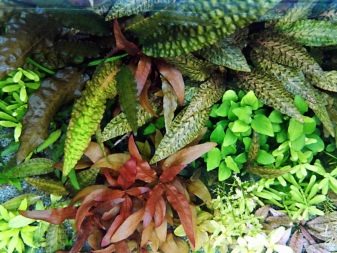
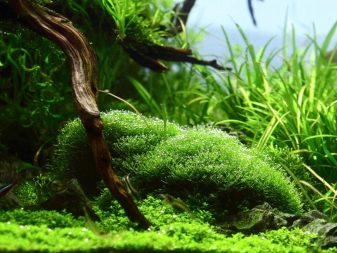
Marsilia - A group of aquatic ferns, including about 30 plant species. In the aquarium, some species of Marsilia have become widespread - in particular, crescent and four-leafed. These plants are notable for their small size, attractive appearance, and a tendency to intensive growth. Visually, plants of this genus resemble a four-leaf clover. Marsilia, in view of their surprising unpretentiousness, is recommended to beginner aquarists as the first water groundcover.
Echinodorus - a group of bog annuals and perennials, including some species that can grow under water. Plants have short stems, ellipsoid, heart-shaped or rounded leaves, combined into a dense rosette. The color of the leaves depends on the variety, hybrid, or plant shape. Despite the fact that echinodorus are considered very hardy representatives of the aquarium flora, many of them are quite demanding on the conditions of detention.
Hornwort - perennial herbaceous aquatic plant, widely used.This representative of the aquarium flora has long thin stems, pubescent with many dissected leaves. This magnificent decorative grass is not only an adornment of the aquarium, but also serves as a refuge for fry and small fish. Hornworms are also used in the arrangement of spawning grounds, in which they play the role of support and shelter for laying eggs.


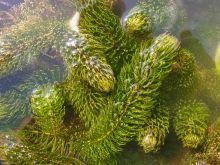
How to choose?
Before acquiring certain types of aquarium plants, it is necessary to calculate their number based on the volume of the reservoir and the size of each representative of the world of the underwater flora. It is worth noting that the dimensions (height and diameter of the crown) of only adult plants should be taken into account. It is also necessary to consider the number and size of aquatic inhabitants that are planned to be kept in the aquarium. Excess vegetation can negatively affect the well-being of the inhabitants of the aquarium, limiting their freedom of movement in space. To a greater extent, mobile and energetic fish suffer from this - for example, zebrafish, swordsmen, barbs.
Besides, excessive vegetation often causes a decrease in oxygen in the aquarium water, which also leads to a deterioration in the well-being of the inhabitants of the tank. This is due to the fact that in the dark, plants have a process opposite to photosynthesis.
So, in the absence of light, representatives of the aquarium flora absorb oxygen dissolved in water and emit carbon dioxide into it. As a result, all the inhabitants of the aquarium begin to experience oxygen starvation.
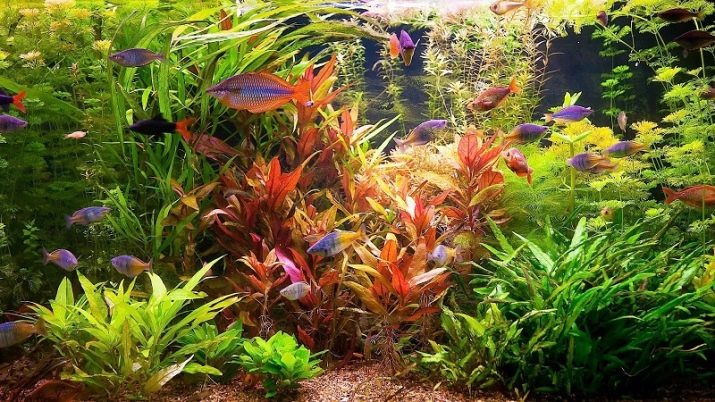
When choosing aquarium plants, you also need to consider the conditions of their maintenance. It is important that they coincide with those conditions that are required by fish and other inhabitants of the home reservoir. This applies to temperature, hardness, acidity of the water, the level of salt, carbon dioxide and other parameters in it. Another important aspect that needs to be considered is the nutritional preferences of the inhabitants of the home reservoir. It is known that many representatives of the aquarium fauna love to feast on underwater vegetation. So, goldfish are able in a short time to almost completely destroy the green aquarium decor of hornwort and duckweed.
Experienced aquarists recommend filling your home pond with about 50% vegetation. However, here you should also take into account the number of decor items, and the thickness of the soil, and the size of the stones that will be used in the design of the tank. When choosing plants for a home aquarium, you should draw up a plan for their subsequent placement on paper in advance. It is made taking into account the following parameters:
- dimensions of the aquarium;
- habitus of plants, their color;
- a combination of plants among themselves in color and shape;
- plant height, diameter of their crown;
- growth rate and direction;
- translucency of green mass (foliage, stems).

Tall plants are placed along the back and side walls of the aquarium, ground cover and dwarf plants are placed at the front wall. The center of the tank is usually left free so that nothing could interfere with the overview of the interior. Recommended list of unpretentious plants:
- plants for the frontal part - miniature echinodorus, duckweed and water lilies, Javanese moss, New Zealand grass;
- plants for the central part (freestanding and shrubbery) - Indonesian thistle, Sumatran fern, red lotus, green and striped calamus, small strelitzia;
- plants for the background - wallisneria, cinnamon, giant echinodorus, elodea.
When choosing and buying aquarium plants, special attention should be paid to their appearance and general condition. These characteristics make it possible to judge the health of representatives of the aquarium flora. Visually, the plant should correspond to its biological description. Leaves, roots and stems should have dimensions, color, structure and turgor typical for this species.
Upon examination, there should be no signs of decay and decomposition, sticky mucous deposits, black or brown spots and dots. The bright white or brown-black color of the roots, holes and frayed edges on the leaves, yellowing of the edges of the leaves, the tops of stems and growth points can also indicate damage to plants by fungal or viral disease.

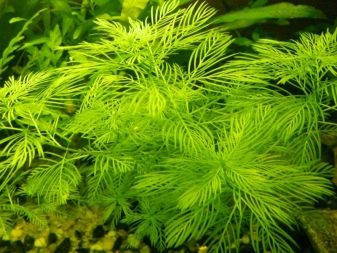
How to plant?
Some representatives of the aquarium flora can be sprouted from seeds, others can be planted in the soil with full-fledged plants, and others can simply be sent to "free swim" through the tank.
Seeds
Before planting, the seeds of aquatic plants must be treated with a stimulant, keeping them in a solution of "Kornevina" or "Heteroauxin" for several hours. After that, planting material is germinated in a jar of clean, settled water, placed in a warm place. The water temperature in the bank should be stably maintained at 24 ° C and no more.
After the seeds sprout, they are grown in a jar of water and fine-grained soil - clean sand, fine stone, vermiculite. The distance between the seedlings should be sufficient so that young plants can fully develop. It is allowed to germinate seeds in a jar with moist soil.
During germination, it is important to constantly maintain high humidity in the tank with regular spraying.
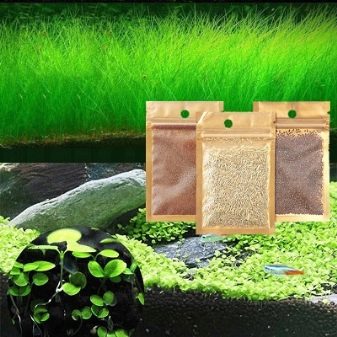

Young plants
Before planting, it is necessary to fill the aquarium with soil and a nutrient mixture (substrate). The need for laying the substrate is due to the fact that the vegetation in the aquarium for the full development and growth will require micro and macro elements. The shortest way to get them is through the root system of plants. The substrate is laid on the bottom of the tank, after which a layer of soil is poured. The thickness of the substrate and soil layer is calculated depending on the size of the aquarium and the length of the roots of the selected plants. Typically, aquarists fill the nutrient mixture and substrate with a layer of at least 5-7 centimeters.
Before planting in the ground, each plant is carefully inspected, weak and damaged stems and leaves are removed. The root system is slightly shortened, cutting it with a clean disinfected knife or scalpel for a couple of centimeters. Next, the plant is briefly sent to a container with saline. This procedure will destroy the harmful bacteria and parasites that may be present on leaves, stems and roots.
After treatment, the plants in saline proceed to planting. To do this, a hole is made in the thickness of the soil, the depth of which will fix the roots in a vertical position. It is not allowed to plant plants in tight and shallow pits, in which their root system will be tightly compressed, flattened or bent up.
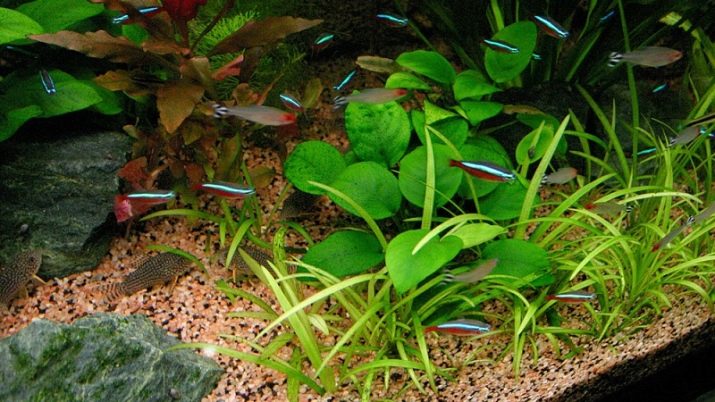
After planting, the seedling is neatly fixed, squeezing the substrate around its stem from all sides. The next step is to fill the tank with water. Aquarists recommend that this procedure be carried out gradually, over the course of several days. During this time, the root system will be able to strengthen in the substrate.
So that the plants do not float, it is recommended that before planting, small weighting agents be fixed on their stems or the bases of rosettes - small fishing weights, stainless steel nuts. When decorating snags and large stones with Javanese moss, plants should be carefully wound to the support with thin fishing line in several rows. Over time, the moss will grow and hide a fishing line underneath.
Instead of fishing line, you can use a piece of capron, which wraps any object (driftwood, stone) with a clump of Javanese moss fixed on it. After some time, the moss will break through the microscopic holes in the capron and completely cover its surface.
During planting, it is advisable to use a special aquarium tweezers. It is convenient for them to plant medium and small, fragile and thin plants both in the bottom soil and in pots.
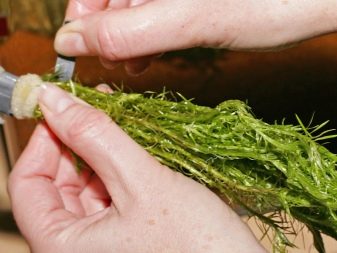

Plants without planting
Representatives of the aquarium flora that do not require planting deserve special attention. These include the following plants:
- duckweed;
- nasyas;
- naiad;
- salvinia;
- limnobium.
These specimens are not planted in the ground, but simply released into a filled aquarium. Floating on the surface, they extract the necessary nutrients from the water and participate in the process of photosynthesis along with other vegetation.

How to contain?
In order for aquarium vegetation to fully develop and grow (and its individual species can even bloom), it is necessary to provide it with optimal conditions. They believe that the following requirements are met:
- adequate lighting;
- optimal water parameters (hardness, acidity, temperature);
- the optimal level of carbon dioxide in water;
- optimal content of micro and macro elements in water (provided by periodic top dressing);
- regular care.
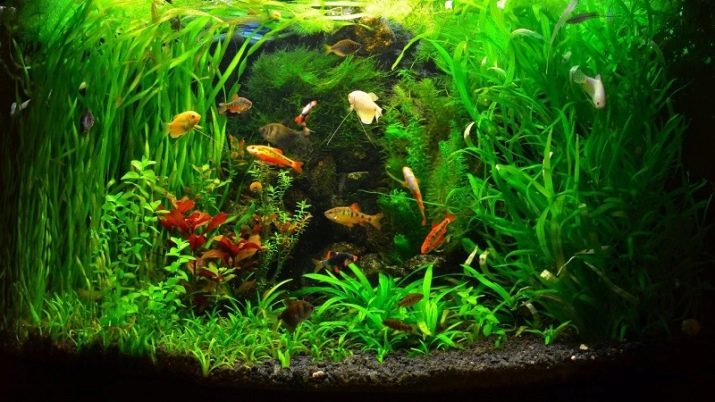
Lighting
Most representatives of the aquarium flora are photophilous plants. The daylight hours for them should be at least 10-12 hours. Experienced aquarists recommend in the organization of aquarium lighting to focus on the following indicators of luminous flux:
- 50-55 lm (lumen) per liter - for unpretentious plants;
- 70-80 lm per liter - for plants with an average level of lighting requirements;
- 110-130 lm per liter - for plants with high lighting requirements.
When organizing lighting, it is important to consider the height of the plants and the water level in the aquarium. It is logical that soil protectors and dwarf plants covering the bottom will receive less light than their higher and larger counterparts.
In this case, it is advisable to install additional lights in the lower part of the aquarium.
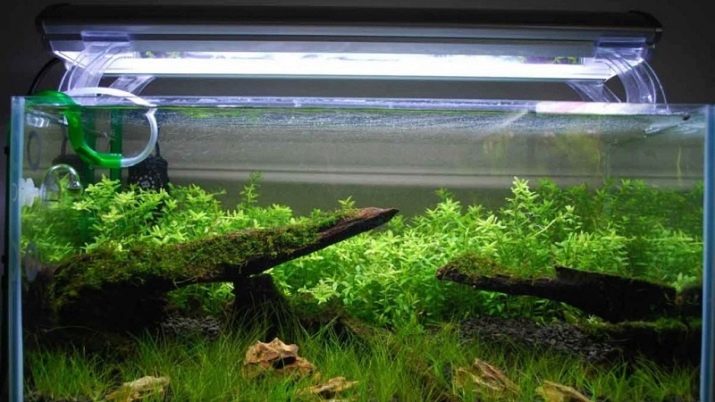
Water parameters
Optimal for most aquatic plants. are the following indicators of acidity and water hardness:
- pH 6.5-7.3;
- dH - 6-12 ° (but not above 15 °).
Some rare and exotic species of aquarium vegetation need different water parameters. For certain species (for example, for representatives of marine aquatic life), the level of salts is also important. The optimum level of water temperature for many types of aquatic plants is considered to be the interval of 24-25 ° C. When the temperature drops below the mark of 22 ° C, some representatives of the aquarium flora slow down significantly, while others - pale and change color.
It is important to consider that for some types of aquarium fish the most comfortable is cool water. Such representatives, in particular, include goldfish.
For this reason, their content should be selected for the aquarium vegetation with similar requirements for water temperature.
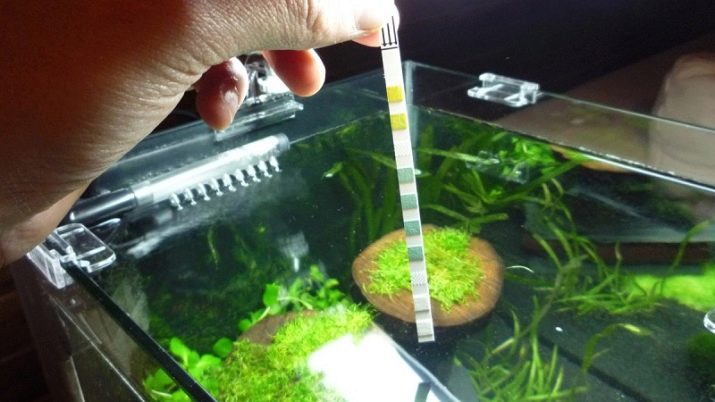
Carbon dioxide level
For the full process of photosynthesis, aquarium plants need the presence of carbon dioxide (CO2) in water. Typically, a deficiency of this component is noted with increased water hardness or in the absence (of a small amount) of fish in the aquarium. In this case, the use of special equipment, an automatic CO2 supply system, makes it possible to fill the carbon dioxide deficiency.

Micro and macro elements
A huge role in the full development of the aquarium flora is played by nitrogen, potassium and phosphates (NPK). With a deficiency of these components, the health and appearance of plants begin to deteriorate - their growth slows down, foliage grows smaller, deformed and loses its color saturation. To avoid imbalance or lack of these components in the water, experienced aquarists recommend the use of ready-made complex feeding - for example, PlantaPro Macro from the famous Tetra brand. Before using this tool, you should use special test strips to analyze the water for the content of these chemical elements.
When preparing macro-feeds with your own hands, take into account that the ratio between nitrogen-containing (N) and phosphate-containing (P) components should be on average 15: 1 (N and P, respectively). The volume of potassium supplements should vary between 10-20 mg per 1 liter of water. The universal feeding for the green inhabitants of the aquarium can be ordinary clay - green, blue, white.
It should be noted that in green and blue clay the maximum content of nutrients necessary for aquarium vegetation is noted.


Care
Caring for most of the aquarium flora is very easy and not burdensome. In general, the main care of plants is reduced to their regular thinning, removal of old and damaged fragments (leaves, stems) and cleaning of contaminants (microalgae, fish waste products, and feed residues).
How to propagate?
Most often, aquarists propagate aquatic vegetation with help:
- cuttings;
- shoots;
- division of the colony (for mosses).
When propagated by cuttings from healthy adult plants, a suitable fragment of about 16-17 centimeters long is separated, at least 3 knots are present. Then the foliage is removed from the lower 2 knots and the stalk is dripped into the aquarium soil. Dip the stalk so that the substrate completely covers the lower nodes, freed from the leaves - in the future they will form the root system. In this way, plants with long stems are propagated - for example, elodea.
Many aquarium plantations can be propagated by lateral or creeping shoots (layering). When these daughter parts of the plant get stronger and fully formed, they are separated from the mother bush and planted in a permanent place. In this way, Wallisneria, cryptocoryne, some ferns are propagated. Mosses (in particular, Javanese) are usually propagated by dividing a large fragment into smaller ones. They are fixed with a thin strong thread or fishing line on stones, branches and other objects of aquarium decor. Over time, young moss colonies will grow and completely hide the supporting surfaces underneath.

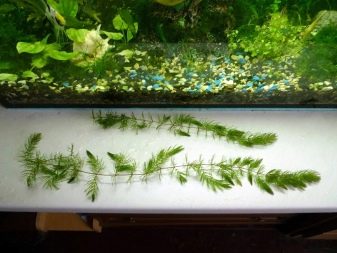
Possible diseases and their treatment
Most often, aquarium plants begin to hurt or die due to violation of the conditions of detention or non-compliance with the rules of care. So, if plants suddenly stop growing, and calcareous deposits begin to form on their leaves, this indicates a sharp and significant reduction in the amount of CO2 in the water. The problem is eliminated by increasing the number of fish and installing a carbon dioxide auto-feed system. If the leaves of aquatic plants turn yellow, turn white, grow poorly or die off, it is necessary to urgently fertilize with nitrogen-containing fertilizers. In addition, you should lower the water temperature by 2-3 ° C. This will compensate for the lack of nitrogen in the water, which is usually the source of the problem.
Unpretentious plants like cryptocorins often suffer from a disease whose etiology is still not precisely established. With this disease, the leaves of the plant turn into a mucous substance, rot, dissolve in water or fall apart. Most often, this problem occurs when the plant enters unusual conditions. It is usually not possible to save the remains of green mass (even when transferring the plant to another reservoir). However, the roots of this disease do not suffer and in the future, after adapting to new conditions, form new healthy shoots.
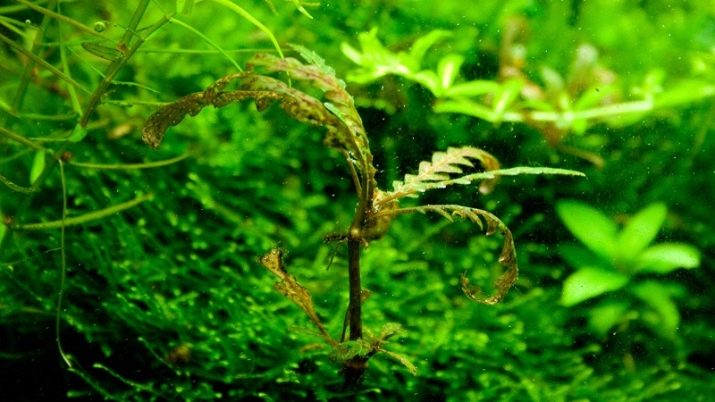
One of the most complex and unpleasant diseases that is difficult to treat is black beard. Its characteristic feature is a black dense coating, covering not only plants, but also decor, and the walls of the tank. The fight against this problem requires an integrated approach and quite a long time (usually it takes about a month to remove a black beard). The first thing to do in this case is to urgently remove deposits of plaque from the aquarium.Additionally, thoroughly clean the soil, make a partial replacement of water (about a third).
The fish can temporarily be deposited in another tank, since the remnants of their food after each feeding will serve as food for the parasitic algae. Partial water changes should be done at least twice a week.
In very difficult cases, it is advisable to use special chemicals, after removing all the fish from the infected tank.
In the next video you will find all the secrets of growing aquarium plants.










